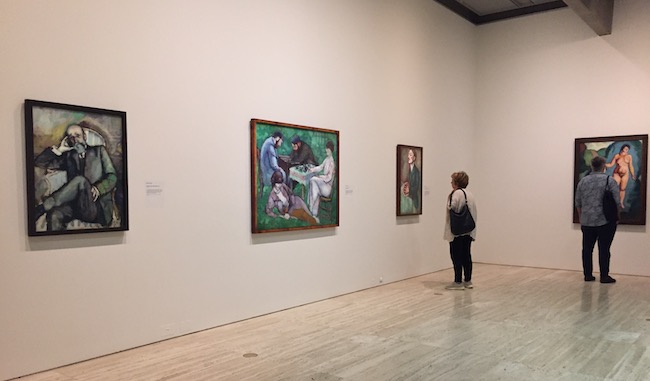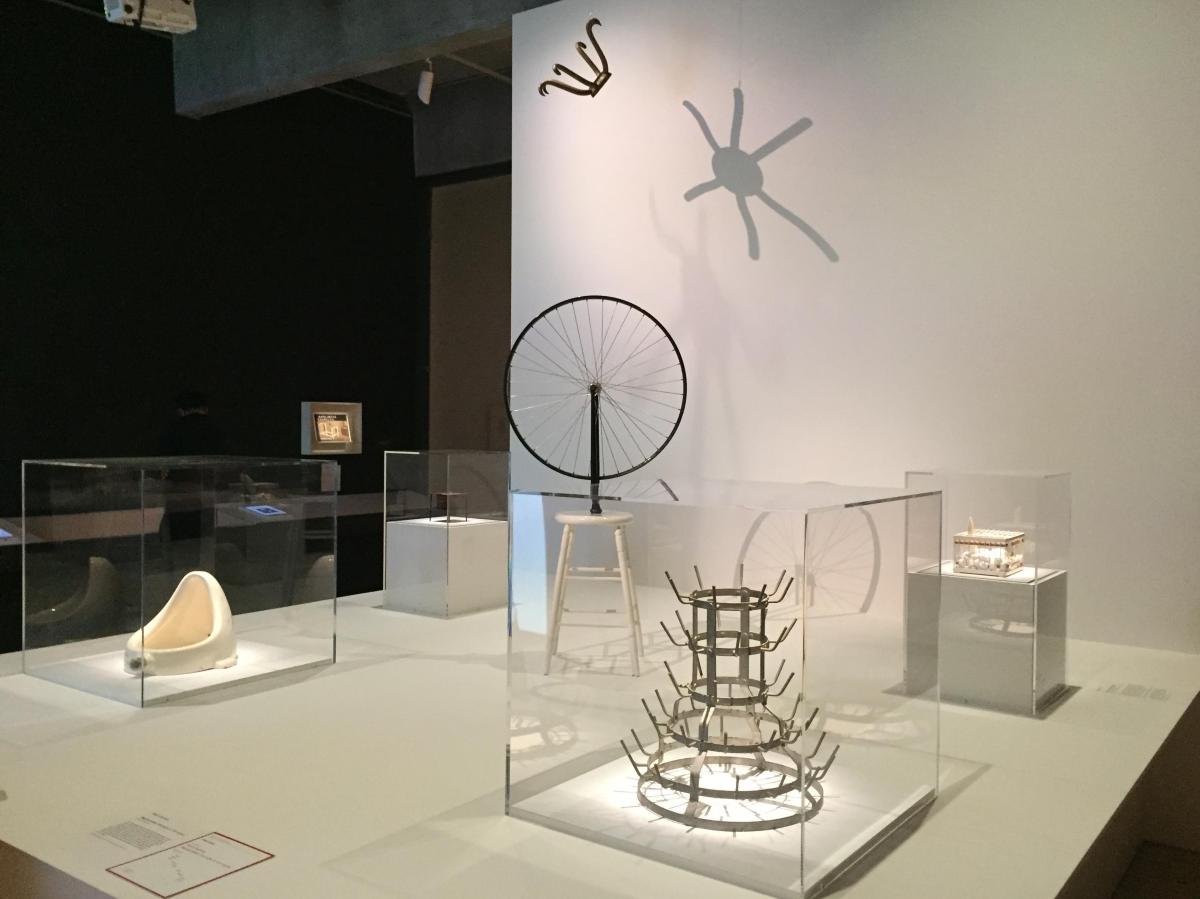Installation view of The essential Duchamp, Art Gallery of NSW. Image: ArtsHub.
Marcel Duchamp (1887-1968) is the stuff of legends – a household name – and yet a new exhibition, which has travelled from America to the Art Gallery of NSW (AGNSW), takes the viewer beyond Duchamp’s iconic readymades into a complex and layered world that still has resonance today.
Curated by the Philadelphia Museum of Art, which holds the largest repository of Duchamp works and archival material, The Essential Duchamp brings over 125 works to Sydney. It’s promoted as the most comprehensive survey of the artist’s work to date in the Asia Pacific region.
They are selling points hardly required; Duchamp’s name itself is a beacon for artists. There was a swell on social media in the days following the exhibition’s opening with artists heralding its brilliance.
Of the 125 works, however, there are only a handful of paintings, and an even smaller handful of readymades – with the bulk of the 100+ objects being archival materials, photographs, notebooks, and various other printed documentations.
That is not to diminish the exhibition’s quality; it is a superb piece of scholarly work, but it perhaps doesn’t extend the witty material punch of the readymades, which have nurtured audience’s understanding of who Duchamp is – and which they expect to see.
Putting Duchamp in perspective
More than a century after Duchamp’s readymade Fountain was banned from the New York Society of Independent Artists spring exhibition of 1917, claiming is was ‘by no definition a work of art’, this conceptual sculpture continues to spur debate.
‘Duchamp’s reputation has never stood higher than it does at present,’ said Timothy Rub, George D. Widener director and CEO of the Philadelphia Museum of Art.
His view was echoed by the curator of this exhibition, Dr Matthew Affron, who said: ‘His impact is seen today in artists’ engagement with multiples and facsimiles, in critical reflection on the display of art in galleries and museums, and in work that deals with commodity culture or explores the connections between gender, sexuality, and art.’
Simply, Duchamp was a provocateur; he challenged the status quo, the powerbrokers, the system. For him, making art was an intellectual preoccupation, more than a studio practice. This exhibition ushers viewers into that understanding.
The exhibition opens with a painting made in 1902, when Duchamp was a schoolboy, Church at Blainville – a light filled, slightly impressionist work. It is totally uncharacteristic.
It is followed by a room of paintings made during 1910-1912, which allow the viewer to literally follow his journey into cubism and beyond.

Installation view of The essential Duchamp, Art Gallery of NSW. Image: ArtsHub.
Among them are The Bush (1910), Portrait of Gustave Candel’s Mother (1911) and Bride (1912), leading to his masterpiece Nude Descending a Staircase No 2 (1912). It is a fabulous trajectory and extremely enjoyable to witness.
Duchamp’s nude was again the subject of great critical attention when it was presented at 1913 Armory Show in New York. ‘Even president Theodore Roosevelt entered the fray, comparing the painting (unfavourably) with a Navajo rug in his bathroom,’ reports The Australian.
‘Yet, even as this magnificent and innovative take on Cubism established his name, Duchamp’s relentless efforts to challenge conventions saw him abandon painting and embark into uncharted artistic territory including the legendary readymades and the development of Rrose Sélavy, his female alter ego,’ said AGNSW Director Michael Brand.
The painting is hung in the exhibition marking a gateway in this history for Duchamp. Entering into the next gallery visitors are faced with a suite of Duchamp’s readymades: Bicycle Wheel (the first to be made in 1914), Bottlerack (1914), and Fountain (1917), among others.
It was about finding a new detachment in art. At just 25, Duchamp had decided he would no longer paint. For the next three years, he drafted notes and made studies for major works. The enormity of what that means on an emerging practice – the discipline in that – is incredible.
It comes together in the work The Large Glass (also known as The Bride Stripped Bare by Her Bachelors, Even) 1915-1923, which is presented as a kind of video tutorial. Duchamp placed the work at the Philadelphia gallery in 1954, and it has not been moved since due to its fragility. It is the kind of epic work we expect of a high-profile artist; the guts of a vision laid bare.
The video is a good solution for including this work. However, between Nude Descending a Staircase No 2 (1912), audiences swooning over this suite of star readymades, and people milling to watch the video, the exhibition feels congested; I have the sense it is not going to flow.
The next pitstop in this exhibition is the experimental film work Anemic Cinema (1926, 7 minutes), which captures Duchamp’s fascination with spinning optical machines, and moved his ideas from art to engineering and gadgetry.
It sits alongside a room of documentation cases, chess boards and photographs. During the 20s and 30s Duchamp is said to have switched his vocation from art to chess, playing professionally. At the same time, though, he invented his female alter ego, Rrose Sélavy, and developed new projects.

Installation view of The essential Duchamp, Art Gallery of NSW. Image: ArtsHub.
It all gets a bit heady and dense at this point. It is not surprising then, that audiences cluster in front of a film accompanying the exhibition, made in 1956, where Duchamp articulates the commonalities he derived in painting and chess. It used ‘the same kind of mental expression’ he professes, among his other philosophies on art.
There is a fractured quality to this exhibition, but then that is reflective of Duchamp’s constant pushing, changing, challenging, searching and experimenting. In a nice touch, the AGNSW invited poets to write texts to accompany the key art works.
Duchamp has been described as a visionary. In our times, when we often speak of innovation and being visionary as the golden ticket forward, perhaps Duchamp teaches a great lesson. We need to be incredibly focused and committed while constantly reaching into the abyss.
Affron told The Australian: ‘In each chapter of the exhibition you find the same artist shedding his skin and becoming a different kind of artist, by virtue of working in different materials and pursuing some of his most persistent aesthetic questions from new directions.’
It is a rare exhibition that warrants a visit, but also offers a window to the depth of an artist’s practice and is a reminder in our fast world of social media and new cycles, that a bit of slow contemplation also has its merits.
4.5 stars out of 5 ★★★☆
The essential Duchamp
27 April-11 August 2019
Art Gallery of New South Wales
Tickets $16-$20





